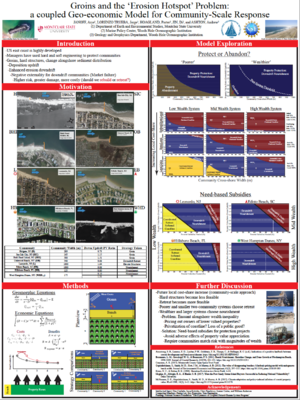2018 CSDMS meeting-058
Log in (or create account for non-CSDMS members)
Forgot username? Search or email:CSDMSweb@colorado.edu
Browse abstracts
A Coastal Geo-economic Model: Property Protection, Federal Buyouts, and Managed Retreat

The US east coast is heavily developed, necessitating adaptive approaches to mitigate property and infrastructure risk from storm events and shoreline changes. One soft-structural approach, beach nourishment, comprises artificial shoreline progradation for property protection. Construction of groins, a hard-structural approach, traps alongshore transported sediments, leading to updrift shoreline growth. Groins create a depositional sediment shadow in their lee, shrinking downdrift shorelines, thereby forcing communities to decide whether to protect properties or to retreat. Our research focuses on how these alternative adaptations may affect coastal risk. We present two field scenarios: West Hampton Dunes, NY, which decided to protect downdrift property through beach nourishment, and Oakwood Beach, NY, which decided to accept buyout offers from federal disaster relief funds. We build a coupled geo-economic model to explore management drivers and controls on coastal morphology and real estate and to analyze the emergent indicators within a two-community system. We quantify benefits as a function of beach width, number of housing rows, and federal property buyouts; costs are a function of groin construction, groin maintenance, and beach nourishment. We compare the net benefits of downdrift nourishment, retreat, and groin removal for different groin lengths, background erosion rates, baseline property values, and discount rates. Results elucidate which approach is most beneficial for coastal adaptation, providing a simple framework to compare future strategies for West Hampton Dunes. This geo-economic tool may prove useful as lawmakers continue to scrutinize fiscal implications of alternative adaptations to coastal risks.
